A good homemade brisket rub keeps it simple. My recipe is a perfect blend of a few simple ingredients: sugar, salt, paprika, onion powder, garlic powder, pepper, mustard, and a dash of Worcestershire sauce. It’s easy to put together, simple to use, tastes wonderful, and stores well in an airtight container.
Having worked at a steakhouse for most of my adult life, I have prepared and used hundreds of rubs, particularly on smoked brisket. This BBQ brisket rub recipe is a hit that has turned several customers into regulars over the years, so I thought I should share it.
Included in this article is the brisket rub recipe complete with alternative suggestions for the ingredients. Stick around to find out the other recipe variations ideal for beef brisket, as well as answers to the most pressing questions regarding brisket rub.
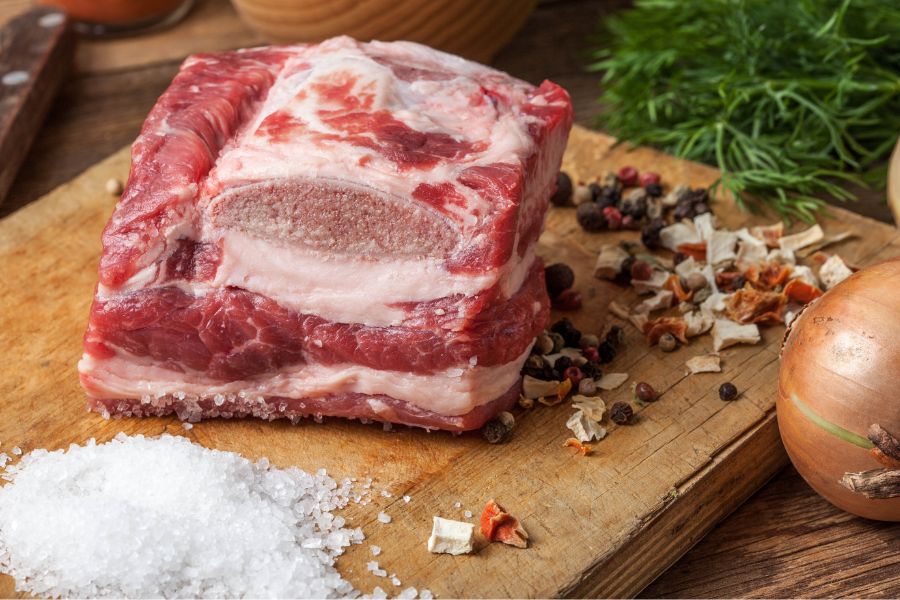
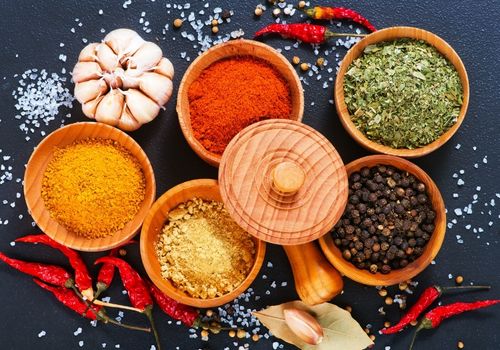
In a medium bowl, make brisket rub by gently mixing the simple seasonings above and rubbing them on the beef brisket.
This simple mixture makes enough rub for 22 pounds of meat. That means it’s enough for an average 16-pound whole packer and a little extra to use with other recipes.
Store the leftover rub in an airtight container or a small bowl covered with plastic wrap.
The beauty of any homemade rub recipe lies in its versatility. Can you customize it to suit your needs? With that in mind, here are ingredient substitutes you could use:
Consider using coconut sugar, plain sugar, or raw sugar like turbinado and demerara which will leave a deeper brown color on your barbecue. Other sweetening options for your brisket include maple syrup and honey.
If health concerns still leave you without options, I have great alternatives like using Agave In The Raw nectar to add a little sweetness to my wet rubs. Agave nectar is low on the glycemic index and has less glucose than sugar.
Brown sugar lends a great taste to beef brisket but too much will leave your brisket sticky.
Kosher salt alternatives include sea salt or coarse salt. If you prefer no salt, try adding lemon juice and zest to your rub for a potent citrus flavor that easily distracts from the absence of salt.
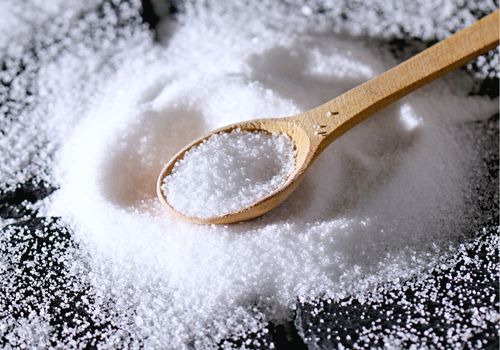
You can replace the chili powder with chili flakes, ancho chili powder, ground chipotle pepper, Aleppo Pepper Powder, or paprika. I use Simply Organic smoked paprika for all my beef brisket recipes.
Substitutes for black pepper include white pepper, cayenne pepper, crushed black mustard seeds, green peppercorns, green peppercorns, and pink peppercorns. Happy Belly black pepper has remained a personal favorite over the years.
Cumin substitutes include fennel seeds, caraway seeds, curry powder, and garam masala.
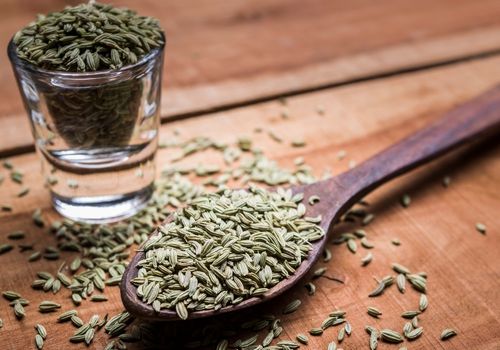
A brisket rub simply refers to a blend of spices applied to a brisket before it’s cooked. Rubs differ in moisture content, texture, preparation methods, and ingredients, but many rubs share similar properties. Let’s take a look:
It’s the base of any good beef brisket seasoning. Salt penetrates the meat fibers as it dissolves, tenderizing them slowly. Brisket rub recipes that do not include salt yield a bland taste, especially when used on large cuts like beef brisket.
That said, if you opt to marinate your brisket before you smoke it, I recommend skipping it in the rub or at least reducing the amount you put in because the brisket will have absorbed enough salt while marinating.
Salt only serves to absorb moisture from the beef to enhance crust formation. Too much of it may make the brisket mushy.
Sugar is a common ingredient in beef brisket rub recipes because it brings a sweetness that enhances the flavor of the rub. It also boosts crust formation by intensifying the brown color of the crust during the cooking process. This is achieved through the Maillard process, also called the browning reaction.
The Maillard process is the reaction between sugar and amino acids present in the brisket. When exposed to heat, the process speeds up producing new compounds that are packed with flavor.
This chemical powerhouse is why sugar should be included in your rub if you’re aiming for a rich, flavorful bark.
A good brisket rub almost always has a savory twist to add flavor to the meat. It pairs perfectly with beef and smoked poultry dishes. Savory ingredients commonly mixed into rubs include Worcestershire sauce, sesame oil, garlic powder, soy sauce, onion powder, mayonnaise, and vinegar.
For spice lovers who prefer their brisket hot, consider adding fiery ingredients to your rub. The most common spicy ingredient is black pepper.
Other options include red pepper flakes, mustard, chili flakes, cayenne pepper, ground hot peppers, and chipotle.
There is no right way to apply the rub on beef brisket but the consensus is to get the rub on every nook and cranny of the brisket.
To do this, first, place the brisket on a flat working board. Score the surface of the brisket to maximize your bark before pouring the rub. This step is optional.
Go in with your hands and rub it throughout the surface. Do the same on the other side. Now, turn the brisket on its side and move it along the board to scoop up all the extra brisket rub.
I always add a thin coat of salt and pepper right after the rub for more flavor on the bark. Your brisket is now ready for the smoker.
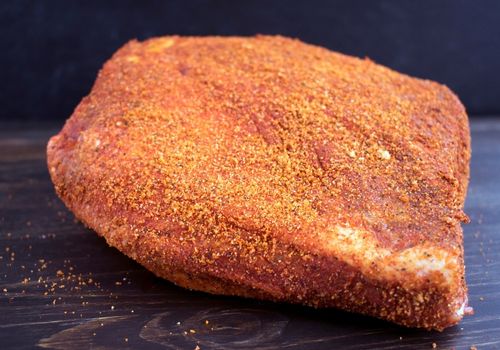
I always go for a fine rub for all my barbecues for two reasons:
First, a coarse rub is harder to apply evenly on the surface of the meat since the spice bits are larger and irregular. A fine rub on other hand is as easy as sprinkling uniformly on the meat.
This, in turn, creates hot spots on the meat that are more flavored than others.
Lastly, a coarse rub always ends up as charred bits of spices after long cooks in the smoker. This is the opposite with a fine rub that can easily blend with the meat.
A binder refers to the ingredient in the rub that serves to adhere to the brisket. A binder is essential when cooking brisket because it will ensure an even bark.
The binder is the difference between a patchy-looking bark and a uniform one and that’s why I always include it in my meat rubs.
When choosing a binder, keep in mind what you want from your meat. Different binders will yield different results. For example, using yellow mustard will soften the bark of the meat more while a neutral binder like olive oil will yield a nice crispy bark.
The difference between a wet rub and a dry rub is that the former contains moisture, making it suitable for slow cooks that give the fluid time to be absorbed into the meat fibers.
Fluids that are commonly used in wet rubs depend on the flavor profile you’re going for. If you are going for extra sweet, consider using honey, maple syrup, or sweet cooking wine. If savory is more your style, go for vinegar, spicy ketchup, beer, bourbon juice, or mustard.
Dry rubs, on the other hand, don’t contain moisture. They blend exceptionally well with quickly seared meats since the high temp forces the rub onto the meat.
If you’re hell-bent on using a dry rub recipe for your brisket seasoning, consider marinating or dry brining it to boost the flavor.
A smoked brisket rub is made out of spices that have been wood-smoked before being ground into a fine powder. They bring an unmatched deep flavor to smoked brisket.
The most common wood-smoked brisket seasoning is smoked paprika. Others include thyme, cumin, red pepper, chili, and rosemary.
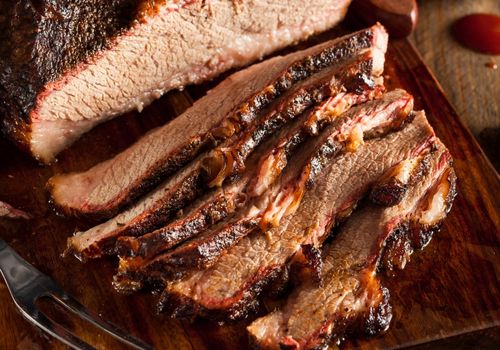
How long you should let the rub sit on beef brisket before smoking depends on the type of rub you use and your palette.
Wet rubs work great when given enough time for the rub to seep into the brisket fibers. This yields very tender, tasty results and a crispy bark especially for large cuts like the brisket.
Wet rubs should sit on your beef brisket for between 4-12 hours. Letting it sit for too long will leave your crust mushy.
A dry rub generally won’t seep deep into the meat and is only used to maximize the flavor of the bark of the meat. The dry rub can be applied anywhere between one hour or right before cooking.
To get the most intense, vibrant notes off your spices, bloom them. Blooming is when you briefly toast your spices in a skillet without adding any oil. Blooming releases the full potential flavor of the spices and renders them undeniably fragrant within minutes.
Blooming your spices is as easy as heating a heavy bottom skillet over high heat and putting in your spices.
Flip often to keep them from getting scorched. When done, crash them into a fine powder and spread generously on your brisket before topping it with a little salt and pepper.
One of the best brisket rub recipes is a classic called the Texas Style brisket rub.
Born out of Central Texas, it is a dry rub made up of a few ingredients. If it tickles your fancy, in a small bowl, mix black pepper, salt, pepper, onion, garlic powder, cumin, and chili powder.
For a great Texas style brisket, I use Lawry's seasoned salt because I love the subtle taste of other spices in the salt.
This rub also stores well as long as it is in an airtight container.
To get a moist, tender brisket, cook it low and slow to allow the fat to render while softening the meat.
Oiling the brisket helps the rub adhere to the brisket especially if you’re working with a dry one. Without it, a significant amount of your rub will simply fall off.